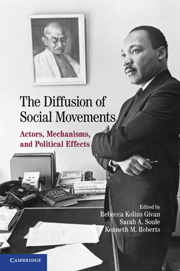Book contents
- Frontmatter
- Contents
- List of Tables
- List of Figures
- Contributors
- Preface and Acknowledgments
- 1 Introduction: The Dimensions of Diffusion
- PART I DIFFUSION AND THE FRAMING OF CONTENTIOUS POLITICS
- PART II MECHANISMS OF DIFFUSION
- PART III DIFFUSION, SCALE SHIFT, AND ORGANIZATIONAL CHANGE
- 10 From Protest to Organization: The Impact of the 1960 Sit-Ins on Movement Organizations in the American South
- 11 Dynamics of Diffusion: Mechanisms, Institutions, and Scale Shift
- General Bibliography
- Index
11 - Dynamics of Diffusion: Mechanisms, Institutions, and Scale Shift
Published online by Cambridge University Press: 05 June 2012
- Frontmatter
- Contents
- List of Tables
- List of Figures
- Contributors
- Preface and Acknowledgments
- 1 Introduction: The Dimensions of Diffusion
- PART I DIFFUSION AND THE FRAMING OF CONTENTIOUS POLITICS
- PART II MECHANISMS OF DIFFUSION
- PART III DIFFUSION, SCALE SHIFT, AND ORGANIZATIONAL CHANGE
- 10 From Protest to Organization: The Impact of the 1960 Sit-Ins on Movement Organizations in the American South
- 11 Dynamics of Diffusion: Mechanisms, Institutions, and Scale Shift
- General Bibliography
- Index
Summary
What are the pathways through which a new form of collective action, a new collective action frame, or a new social movement spreads? Do such collective phenomena diffuse autonomously, or in response to the institutional practices to which they are directed? Under what conditions does the horizontal diffusion of contention give way to broader configurations of conflict – what Doug McAdam and this author have called “upward scale shift” (Tarrow and McAdam 2005; Tarrow 2005)? These are the questions I will take up in this chapter.
Research in the past has focused centrally on the “fact” of diffusion (e.g., does an act of contention diffuse or doesn't it?); it has often traced the pathways of diffusion across geographic and social space; and it has tried to show how, and under what circumstances, diffusion produces new organizations and transmits new collective action frames. These are all important contributions to our understanding of contentious politics. But in each respect, existing research leaves lacunae in our understanding of the dynamics of contention:
First, the “fact” of diffusion can be easily confused with the simultaneous or near-simultaneous emergence of contention in structurally similar situations.
Second, although diffusion always involves emulation, contention can diffuse across geographic or social space through a combination of mechanisms with different outcomes and valences.
Third, as Andrews and Biggs show in their contribution to this volume, when preexisting organizational ecology is taken into account, the diffusion of a new form of contention may have no discernable effect on subsequent organizational expansion (Chapter 10).
- Type
- Chapter
- Information
- The Diffusion of Social MovementsActors, Mechanisms, and Political Effects, pp. 204 - 220Publisher: Cambridge University PressPrint publication year: 2010
- 36
- Cited by

